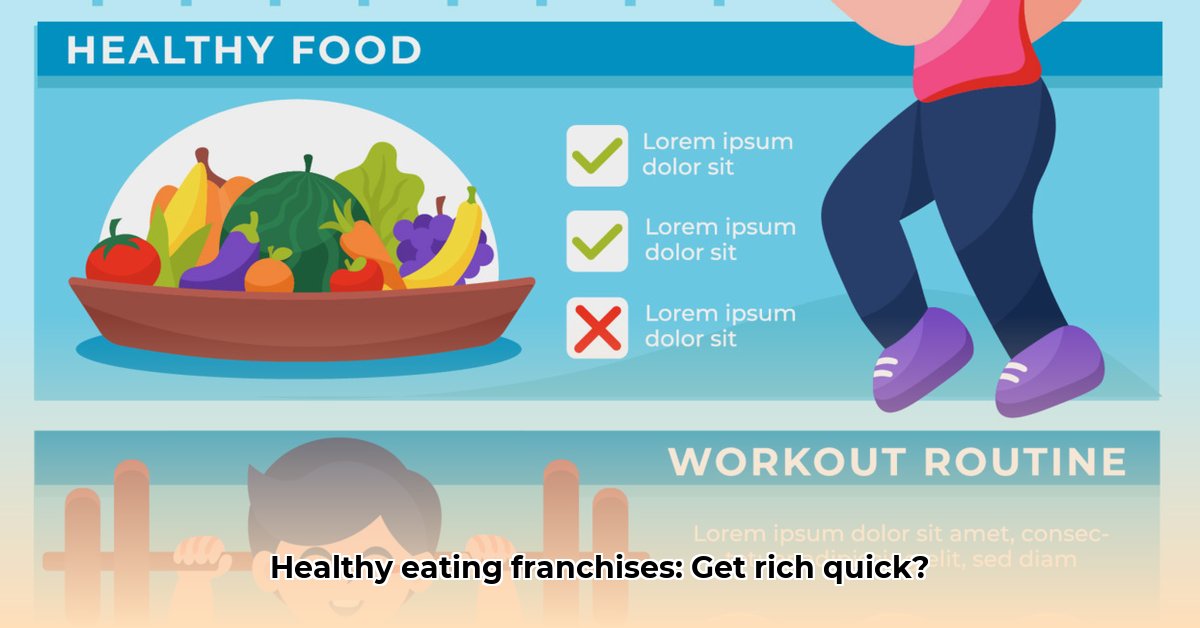Want to cash in on the growing healthy eating trend? It’s a great idea, but starting a healthy food franchise isn’t just about loving salads. You need a smart plan. This guide is your roadmap to success, covering everything from picking the right franchise to making sure your business thrives. We’ll show you how to analyze the market, understand the risks, and track your success. We’ll even give you the inside scoop on marketing your business and making it profitable. Let’s turn your healthy eating passion into a winning business!
Healthy Eating Franchises: Your 2025 Recipe for Success & Sustained Growth
So, you’re thinking about owning your own business? A healthy eating franchise might be the perfect fit as a scalable business model. The demand for quick, nutritious food is skyrocketing, creating a fantastic opportunity for entrepreneurs looking for growth. Let’s be realistic – it’s not all smoothies and salads. Success requires careful planning, data analysis, and a smart approach. This guide will walk you through everything you need to know, including financial KPI and identifying growth opportunities.
Identifying Untapped Niches & Consumer Needs in the Healthy Eating Market
The market for healthy food is booming. More and more people are seeking convenient, healthy options, fueling the growth of healthy eating franchises. But it’s a competitive field. Big names already dominate, but there’s still room for fresh, innovative ideas. Don’t just think smoothie bowls – think outside the box! Consider unique food concepts, catering to specific dietary needs like gluten-free, vegan, or keto, or offering a truly unique experience like farm-to-table organic food options. The key is differentiation. What makes your franchise stand out in the competitive landscape? Analyze current market trends such as delivery-only services, subscription models, and specialized meal programs.
The Money Side of Things: Startup Costs, ROI, and Funding Options
Profitability in this sector varies, influencing investment decisions. Some franchises require a small initial investment, while others need a significant chunk of change upfront. Don’t let the allure of quick profits blind you. Thorough due diligence is crucial for mitigating financial risk, especially when financial forecasting. Carefully examine the Franchise Disclosure Document (FDD) – it’s your roadmap. Analyze projected revenue realistically; avoid pie-in-the-sky promises. Building a sustainable, long-term business is more important than a fast buck. Explore various funding options, including small business loans, SBA loans, and private investors to optimize funding strategy.
Key Performance Indicators (KPIs): Measuring the Success of your Healthy Franchise
Regularly tracking key performance indicators (KPIs) will give you invaluable insights into your franchise’s health. Here’s what you should be monitoring to ensure long-term profitability and market share:
- Customer Acquisition Cost (CAC): How much does it cost to attract a new customer? Keep this low to maximize profits. Strategies include targeted social media campaigns and local partnerships.
- Customer Lifetime Value (CLTV): How much revenue will a single customer generate over their relationship with your business? Aim for high CLTV, a key indicator of customer loyalty.
- Average Order Value (AOV): What’s the average amount customers spend per visit? Consider upselling or offering combo meals to maximize spending and bundling options.
- Food Cost Percentage: This shows how much of your revenue goes directly to buying food. Keep a close eye on this; efficient food management is crucial to controlling costs.
- Employee Turnover Rate: High turnover means constantly training new staff, which is costly and disruptive. Aim for employee satisfaction and retention through competitive wages and benefits.
These metrics provide a clear picture of your business’s performance and brand awareness. Analyze them regularly and adjust your strategy accordingly to achieve sales targets. Optimizing employee retention can improve profitability by up to 25%. By actively monitoring and optimizing these KPIs, franchise owners can make informed decisions to drive growth and maintain a competitive edge.
Risk Management: Building Resilient Franchises & Contingency Planning
Running any business comes with risk. The healthy eating franchise world is no exception. Here’s a realistic look at potential problems and how to address them:
| Risk Factor | Likelihood (Low/Medium/High) | Impact (Low/Medium/High) | Mitigation Strategy |
|---|---|---|---|
| Supply chain disruptions | Medium | High | Diversify suppliers; negotiate long-term contracts; maintain a healthy inventory buffer; develop secondary suppliers; implement inventory management software. |
| Changing consumer trends | High | Medium | Stay up-to-date on food trends; conduct regular market research; be prepared to adapt your menu quickly; embrace new food trends; use customer feedback surveys. |
| Intense competition | High | Medium | Develop a strong brand identity; offer competitive pricing; provide exceptional customer service; build a loyal customer base utilizing influencer marketing; offer loyalty programs. |
| Economic downturn | Medium | High | Develop cost-cutting strategies; emphasize value; clearly communicate the value proposition to customers; offer value-added bundled deals; offer budget-friendly options. |
| Health regulation changes | Low | High | Stay informed about changing health regulations; ensure compliance with all local, state, and federal laws; consult with legal experts. |
Your Step-by-Step Guide to Healthy Eating Franchise Success
Launching a successful healthy eating franchise follows a structured process. Here’s your step-by-step roadmap:
- Market Research: Identify areas lacking healthy options but with high demand, considering local eating habits. Analyze demographic data and competitor analysis.
- Franchise Selection: Research different franchises thoroughly, looking at expansion opportunities. Compare their FDDs carefully, considering fees, support, and the overall business model. Consult with franchise consultants.
- Financial Planning: Create a realistic budget, including potential overhead costs. Secure funding from banks, investors, or personal savings. A detailed business plan is essential.
- Location, Location, Location: Choose a spot with high foot traffic and a customer base that aligns with your brand and target demographic. Negotiate lease terms.
- Building Your Team: Hire reliable, motivated employees who share your passion for healthy eating and prioritize ongoing training. Training and retention are crucial for customer satisfaction; implement employee incentive programs.
- Marketing Magic: Develop a strong online presence using digital marketing. Utilize social media, local advertising, email marketing, and loyalty programs to attract and retain customers.
- Customer Retention: Happy customers are your best advertisement. Loyalty programs and excellent service can build lasting relationships and brand advocacy; implement customer feedback mechanisms.
- Continuous Improvement: The food industry is dynamic. Stay abreast of trends, continuously evaluate your performance, and adapt as needed to meet consumer demand; analyze sales data and customer feedback regularly.
The Future Looks Bright (and Healthy!)
The demand for healthy and convenient food shows no signs of slowing down, presenting lucrative prospects. This translates into significant opportunities for ambitious entrepreneurs and those seeking increased brand recognition. Embrace innovation, stay flexible, and build a business you’re proud of. The future of healthy eating franchises is vibrant and full of potential. Remember, while this guide provides valuable insights, ongoing research and adaptation are key to long-term success in this dynamic industry.
How to Compare Financial KPIs Across Healthy Food Franchises: Data-Driven Approach
Key Takeaways:
- Financial success in healthy food franchises depends on a balanced approach, considering multiple key performance indicators (KPIs) and maintaining efficient resource allocation.
- Comparing KPIs requires a multi-faceted strategy, encompassing financial health, operational efficiency, customer satisfaction, and employee engagement.
- Benchmarking against industry standards and competitors provides crucial context for interpreting your franchise’s performance, revenue growth, and financial stability.
- Different stakeholders (franchisees, franchisors, investors) have unique short-term and long-term KPI priorities needing comprehensive stakeholder management.
- Technology plays a crucial role in streamlining data collection and analysis for informed decision-making and better quality controls.
- Regulatory compliance is paramount when collecting and using KPI data for minimizing legal risks; ensure data privacy and security.
Understanding Your Key Performance Indicators (KPIs) for Financial Health
Before diving into comparisons, you need to identify the right KPIs aligned with business goals, such as increasing brand loyalty. What metrics truly matter for your healthy food franchise? It’s not just about the bottom line. Are you seeing consistent growth in sales? How about customer loyalty through repeat business? Employee retention is key to a positive customer experience? These factors paint a holistic picture of your franchise’s health and ability to provide quality products/services. We’ll look at financial KPIs, but remember, these are just pieces of a larger puzzle. What metrics can help achieve sustainable competitive advantage?
How to Compare Financial KPIs Across Healthy Food Franchises: A Step-by-Step Guide
This process involves more than just looking at numbers, it needs comprehensive market analysis. It’s about understanding context and trends, and using financial ratios for analysis.
Step 1: Define Your KPIs.
- Start with the basics: revenue, profit margins, and costs to analyze financial performance. Track gross profit margin, net profit margin, and operating expense ratio.
- What are your average transaction values? How efficiently are you managing inventory and supply-chain risks? Calculate inventory turnover ratio and days inventory outstanding.
*
- Male Eating Disorders Often Missed but Increasingly Prevalent - October 29, 2025
- Males With Anorexia Nervosa Have Distinct Symptoms and Treatment Needs - October 28, 2025
- Weight Loss for Men Builds Habits for Lasting Success - October 27, 2025










